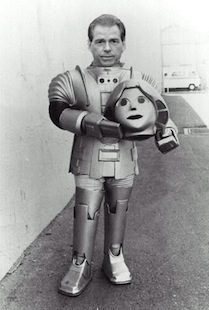 For robot designers, the natural inclination has always been to make their creations look more and more human over successive generations. After all, isn’t it safe to assume that we ultimately want our artificial analogues to reflect their makers’ biological perfection? But there is a danger in this trend, depending on the sorts of applications one expects the robots to be used for. As I argue in this month’s Wired, sometimes an ugly, utilitarian robot is the smarter way to go—at least when it comes to combat:
For robot designers, the natural inclination has always been to make their creations look more and more human over successive generations. After all, isn’t it safe to assume that we ultimately want our artificial analogues to reflect their makers’ biological perfection? But there is a danger in this trend, depending on the sorts of applications one expects the robots to be used for. As I argue in this month’s Wired, sometimes an ugly, utilitarian robot is the smarter way to go—at least when it comes to combat:
Rest assured, robots that resemble their flesh-and-blood creators are on their way to the world’s battlefields. According to a 2004 Darpa survey, US military officers believe that humanoid robots will begin filling out infantry units as early as 2025. Those android grunts will likely be descendants of Petman, a bipedal Boston Dynamics robot funded by Darpa that walks more gracefully than C-3PO. And they may take aesthetic cues from Vecna Robotics’ BEAR, a military prototype that features a rounded head studded with soulful Bette Davis eyes.
Yet despite our love of science fiction, this coming trend in robo-aesthetics is a bad idea. By anthropomorphizing their products, robot designers may unwittingly be encouraging needless bloodshed. Because, as recent research shows, the more human a robot looks, the more likely the Homo sapiens at its controls may be tempted to make the droids go Rambo on their foes.
“Robots don’t need to look like people to get a job done,” says Leila Takayama, a research scientist at the robotics company Willow Garage. “Actually, sometimes it’s better if they don’t.”
The meat of the anti-humanoid argument is that we want to encourage self-extension among robot operators—that is, we want them to really feel as if it’s them on the battlefield, not some million-dollar bucket of bolts and wires. Because the more present the operator feels, the less likely he or she will be to commit morally despicable acts. And researchers have determined that this sort of self-extension happens a lot more when a robot looks like a vehicle rather than an animal or human.
I was a bit saddened to make this discovery, as I would prefer to live in a future where my wars were fought by robots that look like this rather than this. But I’ll admit that my mind has been poisoned by a lifetime of science fiction, so my opinion should count for nothing.


Gramsci // Apr 12, 2011 at 11:26 pm
I think we can all agree that a Nick Saban bot (pictured) would leave the military as soon as the opposing army offered more money.